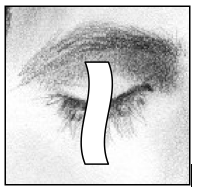The facial nerve supplies the muscles that close the eye and also the tear glands; therefore, the most important medical issue in patients with a facial paralysis is the protection of the eye from dryness or injuries. The following guidelines are important in caring for the eye in patients with facial weakness.
- Frequent use of saline (salt water), such as artificial tear eye drops. Use these drops every 2 hours and more frequently if needed. Even if the eye seems to be closing completely, parts of the sclera (the white of the eye) may be exposed and spontaneous blinking which helps to distribute the tears may be impaired.
- If you have dryness symptoms or irritation in spite of using these eye drops; a thicker, more viscous eye drop such as Refresh Plus® may be more effective.
- A moisture chamber is a clear dome shaped eye cover with a moisture resistant seal that will keep the tears from evaporating as quickly and may be very helpful.
- DO NOT PATCH THE EYE. An eye patch will not keep the eye closed and the open eye underneath the patch may lead to an abrasion (scratch) of the eye cornea.
- At bedtime, place a small bit of lubricating ophthalmic ointment, such as Lacrilube® or Refresh PM®. This may make the vision blurry early in the following morning.
- If the eye does not stay closed at night, the eye can be taped closed with a small 1/2-inch piece of tape (preferably paper tape) placed directly from the lid to the cheek (see illustration at right). This way if the eye does open, the tape will not be against the cornea.
- If the weakness of the eye persists for more than a month or if there is extreme discomfort, your doctor may discuss with you the option of a gold weight implant. This is a weight that can be place into the eyelid to help with eye closure while waiting for nerve recovery.
Facial exercises
Try to exercise when it is convenient at least once a day. If you can exercise several times a day, it would be much better. While you may not be able to make every motion, trying is important, and is the beginning of movement. Even just trying to make the movement will send a message from your brain to your muscle.
Using a small mirror:
- Wrinkle forehead
- Make an angry forehead. Scowl and draw your eyebrows together.
- Wrinkle your nose and sniff.
- Close your eyes tightly.
- Open your eyes wide.
- Squint your eyes (as if from bright sunlight).
- Balloon out your cheeks with air.
- Hollow your cheeks.
- Pucker your lips to whistle.
- Open your mouth and drop your jaw evenly.
- Curl your bottom lip under.
- Exaggerate your smile (try for symmetry).
- Show as many of your teeth as possible.
- Open your mouth wide.
- Run your tongue out straight.
- Curl half of your upper lip upward (sneer to the left and then right).
Other exercises:
- Watch yourself in the mirror while you are speaking on the telephone (to observe symmetry and expression).
- Sing aloud when possible.
- Chew gum while observing in a mirror.
- Arch each of your eyebrows separately, then together
